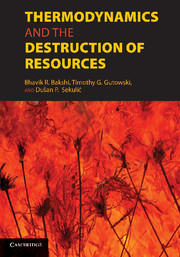Book contents
- Frontmatter
- Contents
- Contributor List
- Foreword by Herman E. Daly
- Foreword by Jan Szargut
- Preface
- Introduction
- PART I FOUNDATIONS
- PART II PRODUCTS AND PROCESSES
- PART III LIFE-CYCLE ASSESSMENTS AND METRICS
- PART IV ECONOMIC SYSTEMS, SOCIAL SYSTEMS, INDUSTRIAL SYSTEMS, AND ECOSYSTEMS
- 14 Early Development of Input–Output Analysis of Energy and Ecologic Systems
- 15 Exergoeconomics and Exergoenvironmental Analysis
- 16 Entropy, Economics, and Policy
- 17 Integration and Segregation in a Population – a Thermodynamicist's View
- 18 Exergy Use in Ecosystem Analysis: Background and Challenges
- 19 Thoughts on the Application of Thermodynamics to the Development of Sustainability Science
- Appendix: Standard Chemical Exergy
- Index
- References
14 - Early Development of Input–Output Analysis of Energy and Ecologic Systems
Published online by Cambridge University Press: 01 June 2011
- Frontmatter
- Contents
- Contributor List
- Foreword by Herman E. Daly
- Foreword by Jan Szargut
- Preface
- Introduction
- PART I FOUNDATIONS
- PART II PRODUCTS AND PROCESSES
- PART III LIFE-CYCLE ASSESSMENTS AND METRICS
- PART IV ECONOMIC SYSTEMS, SOCIAL SYSTEMS, INDUSTRIAL SYSTEMS, AND ECOSYSTEMS
- 14 Early Development of Input–Output Analysis of Energy and Ecologic Systems
- 15 Exergoeconomics and Exergoenvironmental Analysis
- 16 Entropy, Economics, and Policy
- 17 Integration and Segregation in a Population – a Thermodynamicist's View
- 18 Exergy Use in Ecosystem Analysis: Background and Challenges
- 19 Thoughts on the Application of Thermodynamics to the Development of Sustainability Science
- Appendix: Standard Chemical Exergy
- Index
- References
Summary
Introduction
In the 1930s, Wassily Leontief was putting the finishing touches on his development of the input-output (IO) matrices of the U.S. economy, just in time for its strategic use in converting our industry to a war footing. His process allowed the direct and indirect demands of industry to be estimated for a given gross national product (GNP). The government stated its concepts of the needs for the items of war in terms of the numbers of airplanes, tanks, guns, explosives, and so forth, for each of the four or five years they expected the war to last. Leontief was able to determine, for this final bill of goods, the flows of steel, aluminum, energy, and such needed from each industry, directly and indirectly [1]. Then these flows were compared with the capital stocks needed in these industries to meet the wartime demands. What they found was that the output of war material and energy plus those of personal consumption was not possible given then-current capacities in any of the major sectors. Two major endeavors were soon undertaken: massive new construction programs in steel production and shipbuilding, including conversion of many industries to the production of military items, for example, the auto companies converting to the production of military vehicles, and the substantial reduction of personal consumption of cars, gasoline, tires, and certain kinds of food. How did he do it?
- Type
- Chapter
- Information
- Thermodynamics and the Destruction of Resources , pp. 365 - 376Publisher: Cambridge University PressPrint publication year: 2011
References
- 1
- Cited by



